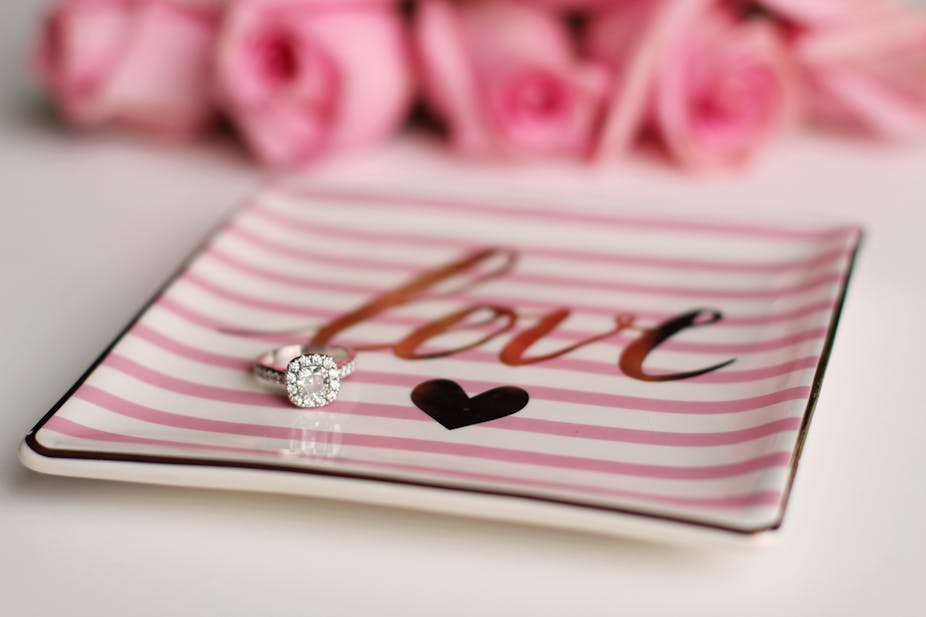“Diamonds are a girls best friend”, so the saying goes. These shiny rocks are durable and pricey. And on Valentine’s Day, it’s likely someone’s new diamond engagement ring will pop up on your Facebook or Twitter feed.
Many couples rely on rings to communicate their deepest feelings to each other and the world. An engagement ring is worth more than its sticker price: it tells family, friends and strangers that you are planning a wedding, you are cherished, you are an adult. It is likely the most expensive and most important object many of us will ever own, but why do we invest sentimental feelings in inanimate objects?
Turning objects into cherished items is nothing new. People have been spinning tales about why things matter to them for centuries. Think of your favourite teddy bear, your baby blanket, the hand-me-down furniture and bric-a-brac around your home. These objects may be crafted from ordinary cotton, wood or clay, but our feelings about them turn them into valuable assets. We cost them well above their price in the marketplace.
Not just a ring
It’s a story I know all too well. Over ten years ago, as my now husband and I were starting to talk marriage, I asked my mother if she was ready to part with her grandmother’s engagement ring. The setting needed work, she said, and the “diamonds” were small (I believe she used the word “paste”).
It was clear she wasn’t ready. And after all, I had never even met my great grandmother. Margaret had endured an unhappy marriage: she left her husband in 1925 and divorced him in 1941 (the grounds were adultery). How could this ring possibly ensure anyone’s happiness?

Two years after my son was born, my mother bestowed this ring, of no great monetary value, upon me. We both teared up. Three weeks later, I lost the ring. I turned our house upside down searching for it. I cried. I lied to my mother about how much I was wearing it.
Six months later, my toddler ran into my bedroom, gleefully brandishing a small, shiny object he had discovered (or more likely squirrelled away). It was the ring. I screamed. I cried again. I rang my mother to confess. The ring had transformed from a keepsake passed from mothers to daughters for three generations into a new tale of lost and found.
Stories about objects
In the 18th-century, dozens of writers took to a new form of fiction that focused on ordinary things – coins, banknotes, shoes, carriages, dolls. These stories brought things to life, granting them their own voices. Today literary scholars call them “object-narratives” or “it-narratives”, so named after their inanimate protagonists. Think Toy Story, Georgian-style.
My own research into 18th-century clothes has meant reading novels narrated by waistcoats, petticoats, shoes and slippers. Georgian object narratives overflow with scandalous gossip about the foibles of humans.
The brothel is a frequent stop in these tales of circulation and the truths (mostly of the bedroom variety) owners seek to conceal from the world. And at the time, these stories became so popular that book reviewers complained about them flooding the literary marketplace.

By the late 18th-century, the genre had grown up to focus on children and their possessions. Children could read about The Adventures of a Pincushion, the Life and Perambulation of a Mouse, The Adventures of a Whipping-Top and The Silver Thimble. English professor and author Lynn Festa has written brilliantly about how these stories instructed Georgian children to care for their things: good owners made good British subjects. And in this way, it’s not hard to see how these stories paved the way for books like The Velveteen Rabbit and Paddington Bear.
The story of things
Last year, I led a school project that taught children how to recreate these tales. In the Story of Things, year four and five pupils devised their own versions of the histories of secret dresser drawers, tea caddies, dolls, shoes and yes, many chamber pots, inspired by the collection of Georgian furniture at Fairfax House in York.
I thought I was teaching the children, but their brilliant stories convinced me of our continued longing to connect with the objects around us and our imaginative capacities to turn inanimate things into vivid, talkative beings.
On Valentine’s Day, it’s all to easy to feel annoyed by couples advertising their deepest feelings with objects – or by the ever more elaborate stakes of social media ready proposals. But it’s important to remember, that we all hold at least one object close to our hearts – no matter how chic or shabby. And in this way, the stories we tell ourselves about the things we own remind us of the ways we love and are loved by others.

